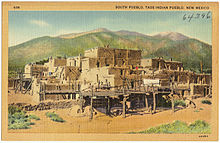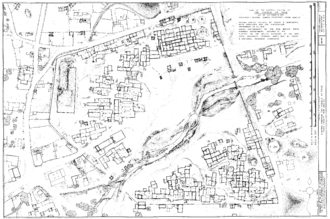Taos Pueblo
![]()
The articles Taos Pueblo and Taos (people) overlap thematically. Information you are looking for here may also be found in the other article.
You are welcome to participate in the relevant redundancy discussion or to help directly to merge the articles or to better distinguish them from one another (→ Instructions).
![]()
This article is about the Pueblo building complex in New Mexico; for other meanings, see Taos Pueblo (book) by Ansel Adams and Mary Hunter Austin.
Taos Pueblo is believed to be the oldest continuously inhabited settlement in the United States. The pueblo is one of the Eight Northern Pueblos, whose inhabitants speak one of two varieties of the Tanoa language. The village consists of two pueblos and is located in northern New Mexico in Taos County on the Taos Indian Reservation on both sides of the Rio Pueblo, also called Red Willow Creek. About 150 Indians of the people also called Taos live in the two main buildings in a largely traditional way of life. In 1992, UNESCO declared Taos Pueblo a World Heritage Site. Taos Pueblo is also a Census-designated place with 1264 inhabitants (as of 2000), 95% of whom are indigenous, and an area of 40.5 km² around the settlement.
Taos Pueblo is a tourist attraction. The monetary income of the inhabitants therefore comes mainly from tourism and from the sale of artworks and handicrafts, which are mainly sold to visitors. Traditional agriculture for self-sufficiency is still important.
Name
Tanoa
In the Taos dialect of the Tanoa language, the pueblo is simply called the "village", with the forms tə̂otho "in the village" (tə̂o- "village" + -tho "in") and tə̂obo "to the village" (tə̂o- "village" + -bo "to, towards..."), respectively. The proper name, on the other hand, is ȉałopháymųp'ȍhə́othə̀olbo "At the mouth of Red Willow Canyon" (or ȉałopháybo "By the Red Willows" as a short form). The name is more commonly used for ceremonial contexts and rarely occurs in everyday speech.
Spanish
The name Taos probably goes back to Tanoa' tə̂o-. The plural s was originally attached to the Hispanicized tao. However, the plural meaning is unknown in the present language. More rarely, one encounters the idea that taos goes back to tao="cross of the Order of San Juan de los Caballeros" (from Greek τ tau, Anthony's cross).
History
The oldest parts of the present buildings date back to the Anasazi culture and were built between 1000 and 1450. The pueblo was built on the slope of the Taos Mountains in the Sangre de Cristo Range.
Time before the European discovery
Most archaeologists believe that the Taos Indians settled along the Rio Grande with other Pueblo Indians after migrating from the Four Corners region. Dwellings in the region were built by the Anasazi (Ancestral Puebloans). It is possible that a long drought in the late 13th century caused the Puebloans to migrate to the Rio Grande where the water supply was more reliable.
In early times, the Taos Pueblo was a central trading post between the inhabitants of the Rio Grande drainage basin and the neighboring Plains Indians to the northeast. In the fall, it was the site of a post-harvest "fair."
Spanish settlement period
The first Spanish visitors reached the Taos Pueblo in 1540; members of the Francisco Vásquez de Coronado expedition visited many of the pueblos in what is now the southwestern United States in search of the fabled "Seven Golden Cities." Fray Francisco de Zamora founded the mission in 1598 on the orders of the Spanish governor, Don Juan de Oñate. Around 1620, Spanish Jesuits directed the construction of the first Catholic church within the pueblo, the Mission de San Geronimo de Taos. Reports from this time indicate that the inhabitants resisted the construction of the church and being forced to join the Catholic religion. Throughout the 16th century, there were growing tensions between the natives and the increasing presence of Spanish colonialists. In 1660, for example, the inhabitants killed the local priest at the time and destroyed the church. It was rebuilt a few years later. In 1680, the Pueblo Revolt began, during which the church was again destroyed and two local priests were killed.
At the transition to the 18th century, San Geronimo de Taos was rebuilt for the third time. The relationship between Spaniards and Taos were even friendly for a short time, as both groups had to ally against a common enemy: Ute and Comanche were advancing into the area. However, the rejection of Catholicism and Spanish culture remained strong. Nevertheless, Spanish religious beliefs and agricultural methods slowly acculturated Taos culture, reinforced by closer cooperation.
US time
Taos Uprising
The Taos Revolt began at the end of the Mexican-American War in 1847. Mexican patriot Pablo Montoya and Tomasito, a leader of the Taos Pueblo, led a militia of Mexicans and Taos fighting against annexation into the United States. They killed Governor Charles Bent and others and marched on Santa Fe. The rebellion was put down and the pueblo was besieged. The rebels took shelter in the mission church. The Americans shelled the church, killed or captured the insurgents, and destroyed the building. Around 1850, a new church was built near the western gate of the Pueblo Wall. The ruins of the former church and the 1850 successor building can still be seen in the Pueblo today. Father Anton Docher first lived as a priest in Taos before serving as a priest in Isleta, where he was given the honorary name "The Padre of Isleta."
20th century
In 1924-25, Swiss psychiatrist Carl Gustav Jung visited Taos Pueblo and studied traditional culture under the guidance of Ochwiay Biano (Antonio Mirabal, Mountain Lake) because he believed that societies living close to nature had more immediate access to archetypes.
The approximately 19,000-acre mountain land that is part of the Pueblo was expropriated by President Theodore Roosevelt and designated as the Carson National Forest. In 1970, it was returned to the Indians under Public Law 91-550 by Richard Nixon. Another tract of 764 acres (309 ha) south of the ridge between Simpson Peak and Old Mike Peak, west of Blue Lake was reappropriated to the community in 1996.

The Pueblo housing complex with Taos Mountain in the background.

Floor plan of the two pueblos

Details of the construction
Search within the encyclopedia